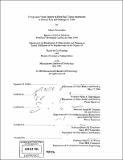Using land value capture to fund rail transit extensions in Mexico City and Santiago de Chile
Author(s)
Covarrubias, Alvaro, 1973-
DownloadFull printable version (19.35Mb)
Other Contributors
Massachusetts Institute of Technology. Dept. of Civil and Environmental Engineering.
Advisor
Ralph A. Gakenheimer and Joseph M. Sussman.
Terms of use
Metadata
Show full item recordAbstract
The effects of rail rapid transit on land uses and land values are discussed. Rail transit can enhance accessibility, and can raise the demand for locating in areas around stations, increasing land value, and in some cases fostering redevelopment at higher densities. The attraction that the areas around stations produce depends on the number of trips generated for unit of land for different types of land-uses. A series of studies on the effect of rail transit on land values are reviewed. Using data from censuses and origin-destinations surveys, the effects of metro lines on land-uses during the 1990's in Mexico City and Santiago de Chile are determined. Results show that in Mexico City neither zones located next to the new lines, nor zones located next to the lines built before 1990 had a higher growth of population, income per capita or employment, as compared to other zones with similar densities and incomes per capita. In the case of Santiago, whereas the areas located next to the newly built line had similar changes to other zones, the areas located next to the two lines built before the 1990's had a significantly higher growth in number of households and average income per capita than other areas, especially in high-income districts. These results are explained by the lower attractiveness of the metro for middle and high-income people in Mexico City as compared to Santiago de Chile, which is proven by specifying relations between ridership and GDP for both cities, using multiple regression models. (cont.) The potential of land value capture as a mechanism for funding rail transit in both cities is discussed, based on the experience of other rail transit systems around the world, and on the characteristics of both metros. In both cases a land value capture system is proposed for new lines. Some guidelines for the implementation of land value capture mechanisms are provided.
Description
Thesis (M.C.P.)--Massachusetts Institute of Technology, Dept. of Urban Studies and Planning; and, (S.M.)--Massachusetts Institute of Technology, Dept. of Civil and Environmental Engineering, 2004. Includes bibliographical references (p. 192-200).
Date issued
2004Department
Massachusetts Institute of Technology. Department of Civil and Environmental Engineering; Massachusetts Institute of Technology. Department of Urban Studies and PlanningPublisher
Massachusetts Institute of Technology
Keywords
Urban Studies and Planning., Civil and Environmental Engineering.